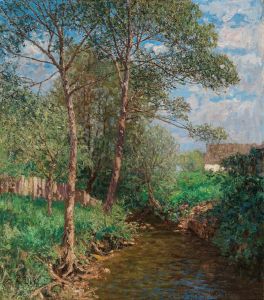
The Little Pool
A hand-painted replica of James Abbott McNeill Whistler’s masterpiece The Little Pool, meticulously crafted by professional artists to capture the true essence of the original. Each piece is created with museum-quality canvas and rare mineral pigments, carefully painted by experienced artists with delicate brushstrokes and rich, layered colors to perfectly recreate the texture of the original artwork. Unlike machine-printed reproductions, this hand-painted version brings the painting to life, infused with the artist’s emotions and skill in every stroke. Whether for personal collection or home decoration, it instantly elevates the artistic atmosphere of any space.
James Abbott McNeill Whistler was an American artist known for his work in the late 19th century, particularly his contributions to the Aesthetic Movement. One of his lesser-known works is "The Little Pool," which exemplifies his interest in capturing the subtle nuances of nature and light.
"The Little Pool" is a painting that reflects Whistler's fascination with the interplay of light and water, a theme he explored in many of his works. Although specific details about the creation and exhibition history of "The Little Pool" are not extensively documented, it is consistent with Whistler's broader artistic style and thematic interests during his career.
Whistler was heavily influenced by the art and culture of Japan, which is evident in his use of composition and color. This influence is part of the broader Japonisme movement that swept through Europe and America in the late 19th century. In "The Little Pool," Whistler likely employed a limited color palette and delicate brushwork to evoke a sense of tranquility and harmony, characteristics often associated with Japanese art.
Throughout his career, Whistler was known for his innovative approach to art, often prioritizing mood and atmosphere over detailed representation. This approach is evident in "The Little Pool," where the focus is on capturing the ephemeral qualities of a scene rather than providing a detailed depiction. Whistler's technique often involved the use of thin layers of paint, allowing him to create subtle gradations of color and tone that contribute to the overall mood of the piece.
Whistler's work, including "The Little Pool," was part of a broader movement that sought to elevate the status of painting by emphasizing beauty and aesthetic experience. This movement was in part a reaction against the more rigid and academic approaches to art that dominated the period. Whistler's emphasis on aesthetic values is encapsulated in his famous credo, "art for art's sake," which suggests that the value of art lies in its beauty and ability to evoke emotion, rather than in its narrative content or moral message.
While "The Little Pool" may not be as widely recognized as some of Whistler's other works, such as "Arrangement in Grey and Black No. 1" (commonly known as "Whistler's Mother"), it nonetheless contributes to our understanding of his artistic vision. Whistler's ability to capture the subtle interplay of light and water in "The Little Pool" demonstrates his mastery of technique and his commitment to exploring the aesthetic potential of everyday scenes.
In summary, "The Little Pool" by James Abbott McNeill Whistler is a reflection of the artist's interest in the aesthetic qualities of nature and his innovative approach to painting. Although specific historical details about the painting are limited, it remains an example of Whistler's broader artistic goals and his contribution to the Aesthetic Movement. Through his delicate brushwork and focus on mood, Whistler invites viewers to appreciate the beauty of the natural world in its most subtle and fleeting forms.






